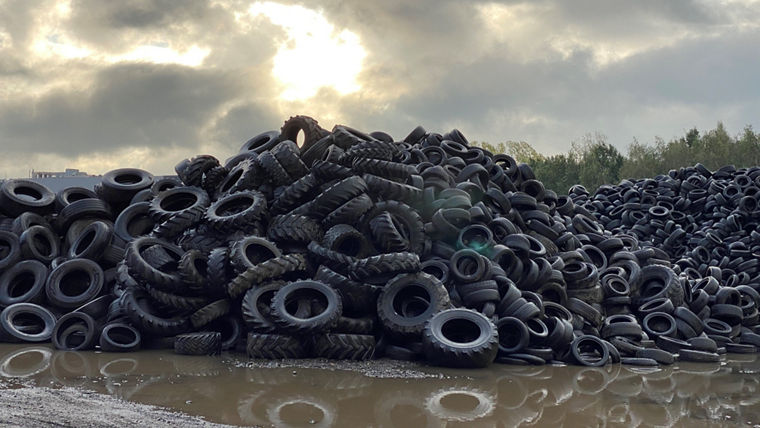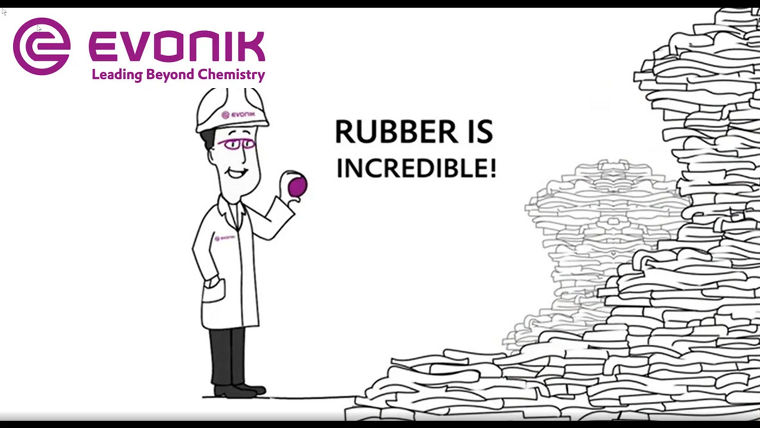Asphalt enables drivers to get to work safely and goods to be transported rapidly. But it’s put to the test before it’s actually used. In a cold chamber at the testing firm PTM in Dortmund, Germany, engineers simulate winter operation on behalf of Evonik. Although the one square meter of asphalt has been cooled in the chamber to way below freezing for days on end, it withstands the sustained stress and doesn’t exhibit any recognizable cracks. Frank Lindner is satisfied with the result. “Our additive VESTENAMER® makes this mixture industrially usable even under tough conditions,” says Lindner, who is a road construction expert at Evonik.
25 MILLION
tons of discarded tires are disposed of worldwide each year
The asphalt in the lab is something special, because it is made from ground rubber contained in end-of-life tires as well as from VESTENAMER® , an additive manufactured by Evonik. “The additives ensure that the asphalt layer is strong but still flexible and also give it an optimal degree of compaction,” explains Lindner. Thanks to the lab results, data now proves that his observations at many real-world road surfaces since the product was introduced several years ago are correct. This data flows into a comprehensive life cycle assessment (LCA) of the additive. In an LCA, the aim is to assess the impact of a product on the environment in a certain application throughout its service life—from its production and its use until its disposal.

“Society in general and customers in particular expect more and more transparency,” says Bernd Schlüter, an expert on Evonik’s life cycle management team. “Life cycle assessments help to make products more comparable.” In order to get meaningful data, the technicians subject the VESTENAMER®-enriched asphalt to extreme conditions. Opposite the cold chamber, the PTM laboratory also contains a facility for simulating the height of summer. Temperatures underneath the system’s glazed lid measure 60 degrees Celsius. Here, a roller at high pressure goes back and forth tirelessly across a piece of asphalt. At such high temperatures, the sustained stress from trucks causes the dreaded ruts. These ruts pose a danger for car drivers whenever rainwater accumulates in them, for example. In this case too, the data shows that the wear and tear is very limited if the asphalt mixture contains ground rubber and VESTENAMER®.

50 PERCENT
of a road surface can be reused, thanks to VESTENAMER®
SUPPORTING ARGUMENTS WITH DATA
An enormous amount of effort is needed for these tests.But why is so much effort being made for a product that only accounts for 0.5 parts per thousand of the surface of a finished road? “The amount plays a subordinate role,” says Lindner and adds, “The crucial thing is what the product does.” Statistics, data, and facts help to demonstrate the product’s benefits.
A lot of convincing still needs to be done. Although it makes sense to use ground rubber in road construction for a variety of reasons, it never really caught on in the past. However, rubber is cheaply available in large amounts in the form of discarded tires. When ground rubber is added to asphalt it gives the mass the desired level of adhesiveness. Unfortunately, the material also sticks to the machines and trucks of road construction companies. The mixture is very hard to handle at normal working temperatures. Higher temperatures require more energy and cause the ground rubber to begin to break down. “In the past, whenever road builders heard the word ‘ground rubber,’ they immediately lost interest,” says Lindner.
VESTENAMER ® demonstrably eliminates these drawbacks. High temperatures are not needed for processing, as mixtures of VESTENAMER ® and ground rubber can easily handle low temperatures as well. Under some circumstances, other mixtures can cool off too fast and can therefore no longer be optimally compacted. In extreme cases this can mean that a road surface that has just been completed has to be entirely renewed.


IDEAL FOR INDUSTRIAL APPLICATIONS
The product from Evonik is a partly crystalline rubber that is known as a trans-polyoctenamer. Its properties are between those of liquid and solid rubber polymers. Before it is vulcanized, it has the characteristics of a thermoplastic. This means that it is hard, heat formable, and easy to work—in short, it’s ideal for industrial applications. VESTENAMER ® is mixed with the ground rubber in small amounts. When it is heated, it melts and covers the rubber particles like a coat of skin. This greatly reduces the tendency of the asphalt-ground rubber mixture to stick to metal. The material slides smoothly out of a truck’s insulated dump body and doesn’t clog the road construction company’s mixer that turns the asphalt into a road surface.
ELEMENTS-Newsletter
Receive exciting insights into Evonik's research and its social relevance - conveniently by e-mail.
0.7 TONS
of carbon dioxide emissions are avoided if a ton of tires is recycled instead of incinerated
“Our additive turns tires that are no longer authorized for road use into high-performance raw materials for road construction,” says Lindner. The data from Dortmund proves that “if we use tires as a raw material here, we can extend the life of their raw materials eightfold.” This effect has a positive impact on the life cycle assessment and also solves the disposal problem. To date, many discarded tires end up in cement factories where they are “energetically recovered” as fuel. There are even some countries that still have tire dumps, which can literally be an inflammable waste of resources.
FIELD TEST IN PADERBORN
The overall result of the life cycle assessment is influenced by numerous factors, says Schlüter: “We also take into account data about possible resource conservation—because the material is used for a longer period, for example.” What this means in practice is demonstrated by Lindner on Detmolder Strasse in the city of Paderborn. This street, which has many shops and restaurants on both sides, is used by several bus lines and witnesses a lot of traffic. In 2012 it was covered with asphalt that contained ground rubber and VESTENAMER® as binders. What’s special about this street is that 50 percent of the new road surface consists of reused material from the old one.

90,000 TONS
of CO2 emissions were avoided during road construction worldwide, thanks to VESTENAMER®
Since 2012, Lindner has regularly visited Paderborn to take a look at the road surface. “It’s still like new,” he says with satisfaction. Road construction companies are trying to increase their reuse rate. Up to 15 percent of a road’s old material can currently be reused for a new surface course. The method that was developed by Evonik can boost this value to 50 percent. If material is no longer suitable for a road surface after it has been reused several times, much of it can still be employed in the underlying base course.
This would benefit the companies as well as the municipalities that commission the building of the roads. If conventional methods had been used, the renovation of Detmolder Strasse would have required 705 tons of new rock and 45 tons of bitumen. As it turned out, only 352 tons of rock and 23 tons of new bitumen were needed—only half of what would otherwise have been the case. This was made possible by seven tons of ground rubber and only 400 kilograms of VESTENAMER®. This reduction also greatly diminishes the logistical requirements. Assuming a truckload of 20 tons and approximately 100 kilometers of distance between the quarry and the mixing facility, for the project in Paderborn the method from Evonik reduced diesel consumption for the delivery of the rocks by a total of 750 liters and thus cut carbon dioxide emissions by around two tons. And this doesn’t even take into account the reduced noise and the decline in traffic congestion. Although the project in Paderborn only involved one kilometer of road surface, Germany alone has more than 170,000 kilometers of secondary roads.
An even more important consideration for reducing CO2 emissions is the fact that every ton of tires that isn’t incinerated but returned to the material life cycle cuts the amount of carbon dioxide that is released into the environment by 0.7 tons. In the case of the project in Paderborn, this translates into 4.9 tons of CO₂. Moreover, Detmolder Strasse is only one of many road projects worldwide that have been carried out more efficiently and sustainably thanks to VESTENAMER® . If the lengths of all of the renovated roads were added together, the distance would stretch from the factory gate in Marl, where VESTENAMER® in roduced, all the way to the Ivory Coast. CO₂ emissions have been reduced by 90,000 tons as a result. By way of comparison, a forest consisting of 90,000 beech trees would have to grow for 80 years in order to store this amount of carbon dioxide. The reduction could even be much greater, because more than half of all tires worldwide are still either dumped into landfills or incinerated—a total of about 13 million tons of tires each year.

New from old
A tire reaches the end of its service life when its tread is worn away. Although it can then no longer be used for safe transportation, the material it consists of is still completely intact. The idea that this material can be reused is by no means new. The simplest way to do this is what’s referred to as thermal energy recovery. Discarded tires are incinerated in cement plants, for example, although this often has to be paid for. From a life cycle assessment standpoint, this kind of use is very bad recycling, because an inherently valuable raw material is used in a way for which there would be better alternatives. A more sustainable method is to shred the tires and turn them into ground rubber. The latter can be used as construction material, for example, or be converted into rubber mats. However, the demand for such products is limited, whereas the supply is huge. About 600,000 tons accumulate in Germany alone every year.
DEMONSTRABLE BENEFITS
Compared to conventional road surfaces, the use of VESTENAMER® could reduce carbon dioxide emissions by 10 to 60 percent during a road’s life cycle, depending on the assumptions made. For Bernd Schlüter, this is a compelling argument for using VESTENAMER® on a larger scale. “This is a non-hazardous product that turns waste into a valuable raw material, lengthens the life of the end product, conserves natural resources, and cuts energy consumption,” he says. “And all of this is demonstrated by verifiable data.”



